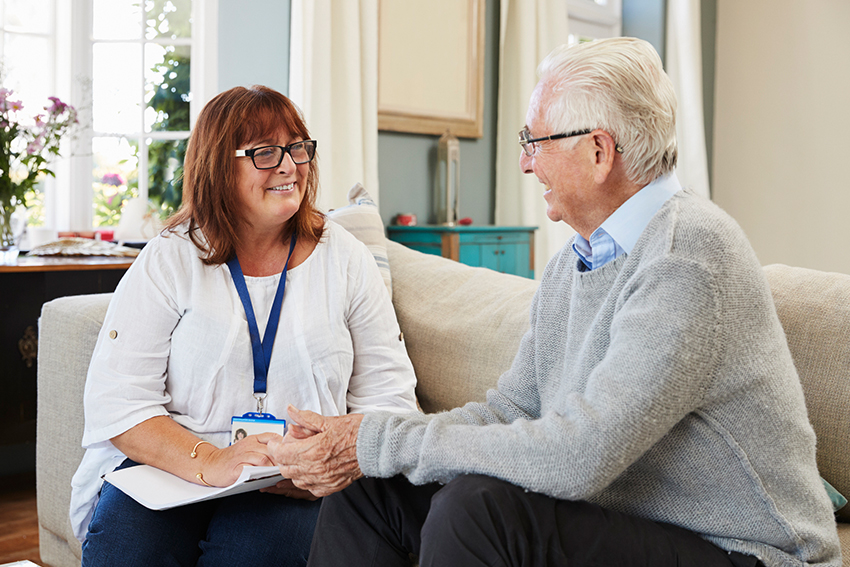Communication and engagement
Communication and engagement are critical in rehabilitation. Through communication, clinicians develop relationships with clients, getting to know who they are, what they need from the clinician, what really matters to them, and how the clinician needs to work with them.
Our research on communication seeks to understand what ‘good communication’ looks like in a variety of rehabilitation contexts by studying client-clinician interactions and exploring the perspectives and experiences of both clients and clinicians. Our research on engagement has sought to critically examine what ‘engagement’ means and how it occurs. Our work has challenged dominant ideas about engagement being the patients’ responsibility, instead demonstrating the critical role that clinicians play in supporting engagement. Communication and relationships appear to be crucial factors in this process. We have a special interest in communication and relationships between clinicians and those living with communication impairment. Our research findings inform our undergraduate and postgraduate teaching as well as workshops and inservice training with clinicians and rehabilitation services.

Research projects
Many services and clinicians are rapidly moving to offer telerehabilitation services in response to Covid-19 and the difficulties in providing face-to-face care. It is clear that telerehabilitation is effective for many forms of rehabilitation, however it is not always straight forward to implement. One reason is that communication is different. In telerehabilitation, we lose nonverbal communication modalities such as touch.
Nonverbal communication is also a key way in which we convey emotion, prompts for action, and information about health and wellbeing. This means we become highly dependent on verbal communication. There are some things that need to be considered to really maximise communication, both before telerehabilitation sessions, and within these sessions.
Resources
The documents here provide a synthesis of material from the literature, expert clinicians and organisations experienced in telehealth. They provide a range of suggestions to optimise communication, engagement and therapeutic relationships in telerehabilitation.
- Things to consider before your session
- Setting up session checklist
- Facilitating good communication in telerehabilitation - Things to consider within the session
- Clients with communication issues
- Clients with cognitive issues
- Resources
These documents are designed to be living documents – if you have areas that haven’t been addressed or resources that you think could be incorporate, please contact Felicity Bright.
Engagement: A conceptual review
Engagement has historically been seen as a patient behaviour and responsibility. We examined the rehabilitation literature, synthesising papers from physical and mental health rehabilitation, to understand all the different ways it has been conceptualised. Papers included were theoretical and empirical, and captured measures of engagement and patient and clinician perspectives of engagement.
What became very clear was that engagement was not simply a patient behaviour or responsibility; engagement occurred as people gradually connected with others and with the broader therapeutic programme. We suggested that engagement “Engagement is a co‐constructed process and state.
It incorporates a process of gradually connecting with each other and/or a therapeutic programme which enables the individual to become an active, committed and invested collaborator in health care”.
We suggest this definition can apply to both the patient and the clinician. Viewing engagement as co-constructed, and as being a process not just a state, prompts clinicians to attend to their role in supporting engagement, considering what they can do to support the patient to connect with themselves through the therapeutic relationship, and with the rehabilitation programme.
Further details
- Felicity A. S. Bright, Nicola M. Kayes, Linda Worrall & Kathryn M. McPherson (2015) A conceptual review of engagement in healthcare and rehabilitation, Disability and Rehabilitation, 37:8, 643-654, DOI: 10.3109/09638288.2014.933899
- Link to thesis
Engaging people with communication disability in stroke rehabilitation
People with communication disability can have particular challenges engaging in rehabilitation. We undertook this research to see how clinicians worked to engage these people in stroke rehabilitation, reflecting we understood engagement as something co-constructed, influenced by the actions and attitudes of the clinicians.
We gathered data through observations, interviews and focus groups, including following four people with aphasia through rehabilitation, observing interactions with over 25 clinicians.
We found that engagement was inherently relational. When enacting engagement as a relational practice, we observed an intentional and reflexive way of thinking, working and being on the part of the practitioner. When enacting engagement as a relational practice, practitioners prioritised getting to know the patient and their needs, and used this knowledge to determine how best to work with them. This could see them emphasise relational or technical, disciplinary-based work depending on the patient’ needs and priorities.
Relational dialogue, an integrated approach to communication, was embedded throughout their interactions. Engagement as a relational practice involved weaving together relational work and communication, together with technical, disciplinary-based work, and rehabilitation tasks. Practice was surrounded by a relational frame, a philosophy of practice.
There was consistency and coherence between how the practitioner thought about engagement and how they enacted it. Engagement appeared co-constructed; each party’s engagement was influenced by their perceptions of the other person’s engagement.
Engagement as a relational practice appeared a skilled, sophisticated way of working. Re-conceptualising engagement as a relational practice may support practitioners to reflect on their understandings of engagement, their patient’s engagement, on their ways of working, and perhaps most fundamentally, the frames and philosophies which surround and influence their practice.
References
- Bright, F. A. S., Kayes, N. M., Cummins, C., Worrall, L. M., & McPherson, K. M. (2017). Co-constructing engagement in stroke rehabilitation: A qualitative study exploring how practitioner engagement can influence patient engagement. Clinical Rehabilitation, 31(10), 1396-1405. https://doi.org/10.1177/0269215517694678
- Bright, F. A. S., Kayes, N. M., McPherson, K. M., & Worrall, L. E. (2018). Engaging people experiencing communication disability in stroke rehabilitation: A qualitative study. International Journal of Language and Communication Disorders, 53(5), 981-994. https://doi.org/10.1111/1460-6984.12409
- AUT open access - Engaging people experiencing communication disability in stroke rehabilitation: A qualitative study
Physiotherapy students’ understandings of good communication
Communication is fundamental in collaborative physiotherapy practice. Students develop understandings of what constitutes ‘good’ communication through the formal, informal and hidden curricula. Understanding how students understand communication and how this is influenced by the curricula can help educators consider how best to enhance communication knowledge and skills.
This study explored how physiotherapy students conceptualised clinical communication. This study was underpinned by a social constructionist epistemology. Data consisted of fifteen assignments, completed by students as part of their coursework. Assignments were analysed using the Listening Guide which prompted attention to how the different ways students understood communication and how these understandings were constructed.
Communication was understood as uni-dimensional. It was presented as an act done to the patient by the physiotherapist, with little attention to the patient’s communication and involvement in the interaction. Through communication, physiotherapists demonstrated and reinforced their expertise while simultaneously positioning the patient as the recipient of care and knowledge.
Understandings of communication reflect broader constructions of physiotherapy and the role of the physiotherapist. These also reflect tensions in the curricula. Enhancing communication in student education requires all parties to understand, value and critically reflect on how communication is constructed and enacted.
Further details
- Bright, F. A. S., Cummins, C., Waterworth, K., Gibson, B. E., & Larmer, P. (2018). Physiotherapy students’ conceptualisations of clinical communication A call to revisit communication in physiotherapy education. . OpenPhysio. Retrieved from https://bit.ly/33hlvCf

Project details
Funders:
AUT Vice Chancellors’ Doctoral Scholarship; Laura Fergusson Rehabilitation Doctoral Scholarship; AUT School of Clinical Sciences Emerging Researcher Grant; New Zealand Rehabilitation Association Emerging Researcher Grant
Principal investigator:
Dr Felicity Bright
Research team:
Prof Nicola Kayes; Christine Cummins
Contact:
Felicity Bright
Key collaborators:
Prof Linda Worrall, Prof Kath McPherson
Timeline:
Since 2015
Status:
Ongoing